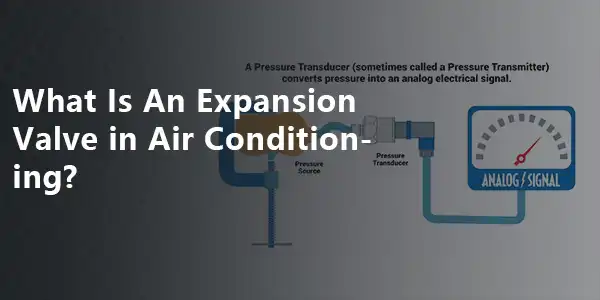What Is An Expansion Valve In A/C System?
The performance of automobile air conditioning systems directly affects the user's riding comfort. The expansion valve is a component in the air conditioning system, and its role cannot be ignored. In this article, MyMROmarts will introduce in detail what an expansion valve is, what it does, symptoms of expansion valve failure, how to test an expansion valve, and how to replace an expansion valve.
What Is Expansion Valve?
What does the expansion valve do? The expansion valve is a refrigerant metering device mainly used to control the flow and pressure of refrigerant. The expansion valve is located between the condenser and evaporator, usually at the inlet of the evaporator. Its main function is to depressurize high-pressure, high-temperature liquid refrigerant into low-pressure, low-temperature liquid or gas-liquid mixed refrigerant. It facilitates the refrigerant to absorb heat in the evaporator to achieve the cooling effect.
The expansion valve controls the size of the orifice to regulate the amount of refrigerant flowing through the evaporator. To control the temperature and pressure in the evaporator. The energy of the refrigerant is used to realize the working principle of the expansion valve.
MyMROmarts online store sells various brands and models of expansion valves such as John Deere 4430 expansion valve, Volvo Truck expansion valve, and 320 305 expansion valve, etc. If you have any needs, please contact us!
What Does AC Expansion Valve Do?
Regulate refrigerant flow
The expansion valve can automatically adjust the amount of low-pressure refrigerant gas flowing through the evaporator according to the actual load of the evaporator. The existence of the expansion valve ensures the complete evaporation of low-pressure refrigerant gas in the evaporator, improving the cooling effect and efficiency of the air conditioning system.
Lowering blood pressure and cooling
The expansion valve throttles and reduces the pressure of high-pressure, high-temperature liquid refrigerant, turning it into low-pressure, low-temperature refrigerant gas. The refrigerant gas absorbs the heat in the car in the evaporator to achieve the cooling effect.
In summary, what does an expansion valve do? It is vital for regulating refrigerant flow, lowering pressure, and maintaining the cooling efficiency of the air conditioning system.
Prevent the evaporator from overheating or cooling
The expansion valve prevents the temperature in the evaporator from being too high or too low by regulating the flow of refrigerant. The existence of the expansion valve ensures the normal operation of the air conditioning system.
A/C Expansion Valve Failure Symptoms
Recognizing the symptoms of a faulty expansion valve is crucial for maintaining the efficiency of your car's air conditioning system.
Reduced cooling effect
If the expansion valve fails or becomes clogged, refrigerant gas cannot flow into the evaporator properly. Eventually, there will be insufficient refrigerant gas in the evaporator, and the cooling effect of the air conditioning system will be significantly reduced.
Evaporator freezes
If the expansion valve cannot regulate the flow of refrigerant correctly. An excessive amount of refrigerant gas enters the evaporator. This will cause the evaporator to freeze, further affecting the cooling effect.
Abnormal evaporator pressure
Failure of the expansion valve will cause abnormal pressure in the evaporator. The specific situation will be that the pressure on the high-pressure side is too high or the pressure on the low-pressure side is too low. Abnormal evaporator pressure also affects the normal operation of the air conditioning system.
Increased system noise
A faulty expansion valve in an AC system can also cause poor refrigerant flow. When working, the air conditioning system will produce noise, affecting the user's driving experience.
How To Test Expansion Valve?
1. pressure test
Use an air conditioner pressure gauge to measure the pressure on the high and low pressure sides. If you find that the pressure displayed on the pressure gauge is abnormal, the expansion valve may be faulty.
2. Temperature test
By measuring the temperature difference between the inlet and outlet of the evaporator. If the temperature difference is found to be too large or too small, it may also be caused by improper adjustment of the expansion valve.
3. Refrigerator flow test
Use a refrigerant flow tester to measure the flow of refrigerant. If the flow of refrigerant is insufficient or excessive, this may also indicate a problem with the expansion valve.
4. Observe the refrigerant status
Check the flow status of the refrigerant by observing the sight glass or other visual devices. If you find that the refrigerant does not flow smoothly or there are bubbles, it means that the expansion valve is faulty.
How To Replace Expansion Valve?
Replacing the expansion valve in car air conditioning requires preparing materials such as wrenches, screwdrivers, refrigerant recovery equipment, new expansion valves, and gaskets.
1. Recycle refrigerant
Before replacing the expansion valve, refrigerant recovery equipment needs to be used to recover the refrigerant in the system. This prevents refrigerant leakage from causing pollution to the environment.
2. Remove the old expansion valve
First, use a wrench and screwdriver to remove the pipeline and fix screws connected to the expansion valve. Then remove the old expansion valve.
3. Install a new expansion valve
Install the new air conditioner expansion valve, connect the pipes, and secure the screws. Finally, confirm again whether the installation is firm.
4. Replace gasket
When installing a new expansion valve, remember to replace the seal with a new one. This can better avoid refrigerant leakage.
5. Evacuating and filling refrigerant
After installation, use a vacuum pump to evacuate the system. Make sure there is no air or moisture in the air conditioning system, and then add an appropriate amount of refrigerant.
6. Test system
Start the air conditioning system and check whether there is a leakage of refrigerant at the expansion valve and each interface. And test the cooling effect of the air conditioner to ensure the normal operation of the system.
 Track Your Order
Track Your Order




